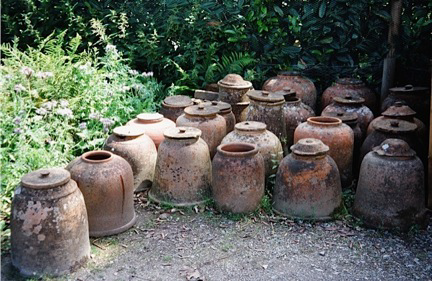Have you ever stopped to consider the benefit of adding perennial food
plants to your garden? Unlike most food plants that are annuals, which rotate around the garden, perennial food plants require a permanent location where they will increase in size and production over time. They are best planted at the edges or the corners of the garden, to keep them from interfering with annual crop rotations. Here are some of my favourites.
Globe artichokes Cynara scolymus are native to the Mediterranean, but given the right situation, they can be long-lived in temperate climates too. Plants grow to 5-feet, reaching a potential of 6-feet across. They prefer full sun and are heavy feeders, needing soil with plenty of organic matter, so feed generously. Cutting them to the ground in November and covering thickly with mulch keeps the roots from freezing in harsh winters. Showy thistle flowers appear from summer to fall. The flowers consist of layers of bracts, which are fleshy at the base, and it’s this fleshy part which is eaten; but it’s the heart of the bud at the top of the flower stalk (dipped in butter and lemon juice) that is the main delicacy.
With asparagus I recommend starting with two-year old male roots, ‘Jersey Knight’ for example. That way you’ll be harvesting asparagus next year instead of waiting three years for yields. The male plants produce the fat juicier spears, while the females produce longer slender spears. Asparagus roots are heavy feeders, keep them happy by feeding the patch every fall.
Welsh bunching onions, Allium fistulosum, are prolific multipliers. A farming friend once told me ‘one is all you need’ and he was right! Every single onion divides into a bunch of scallions, which then can be divided into rows of onions. They are winter hardy and will provide green onions throughout the year.
Arugula sylvetta grows as a small perennial shrub, and is a source of rocket salad said to have a spicier and superior flavour to annual arugula varieties. Just watch out for self seeding, as it can take over the garden.

Photo: Asparagus ‘Jersey Knight’ underplanted by Arugula sylvetta.
Sunchokes, Helianthus tuberosus, (aka Jerusalem artichokes) produce underground tubers that are a good source of carbohydrate that can be harvested in winter as needed. Even if I dig the whole bed up over the winter they come back like crazy! Sunchokes are sweet and nutty when simply drizzled with olive oil and roasted for 25 minutes. They can be used as crudités with dips, marinated, and they also make a hearty creamy winter soup.
 S e a k a l e ( C r a m b e maritima) is a brassica that grows wild on the cliffs of n o r t h w e s t U K . T h e Vi c t o r i a n s forced plants under terra cotta pots in January. The photo shows the pots at T h e L o s t Gardens of Heligan, Cornwall, UK. The delicate shoots were eaten steamed, and were considered a delicacy, tasting like hazelnuts crossed with asparagus. The pure white flowers of Crambe are highly decorative, and are worth growing for this reason alone. You can propagate sea kale from root division or from their light-brown seed pods, best sown in fall.
S e a k a l e ( C r a m b e maritima) is a brassica that grows wild on the cliffs of n o r t h w e s t U K . T h e Vi c t o r i a n s forced plants under terra cotta pots in January. The photo shows the pots at T h e L o s t Gardens of Heligan, Cornwall, UK. The delicate shoots were eaten steamed, and were considered a delicacy, tasting like hazelnuts crossed with asparagus. The pure white flowers of Crambe are highly decorative, and are worth growing for this reason alone. You can propagate sea kale from root division or from their light-brown seed pods, best sown in fall.
Horseradish is prepared as a mouth-searing relish across Europe, North America and Russia, and considered indispensable with roast beef by the British! The large coarse leaves are not eaten, the value lies in the roots, which fatten to 2-inches in diameter if grown in fertile soil. Horseradish is propagated by root division, so digging up roots can result in the horseradish spreading. An alternative is to grow the plants in half oak barrels.
Rhubarb grows best in full sun or light shade in fertile, moist loamy soil. It is either green or red-stalked, the latter being sweeter but less productive, and less suited to forcing. Rhubarb is a gutsy feeder, so it’s best to feed it twice a year, in early spring and again in late fall. To encourage the best production every three years the woody roots should be dug up in early spring or late fall and divided, an axe works well for this. Replant chunks of root three feet apart with the crown just below the surface. The plants come into full production in the third year and they can continue for 15 to 20 years.
Having food automatically pop up in the garden every year makes me feel more food secure, and the plants offer aesthetic beauty, as well as good food value.
 Carolyn Herriot is author of The Zero Mile Diet, A Year Round Guide to Growing Organic Food and The Zero Mile Diet Cookbook, Seasonal Recipes for Delicious Homegrown Food (Harbour Publishing.) Available at your local bookstore.
Carolyn Herriot is author of The Zero Mile Diet, A Year Round Guide to Growing Organic Food and The Zero Mile Diet Cookbook, Seasonal Recipes for Delicious Homegrown Food (Harbour Publishing.) Available at your local bookstore.
See all articles by Carolyn Herriot



